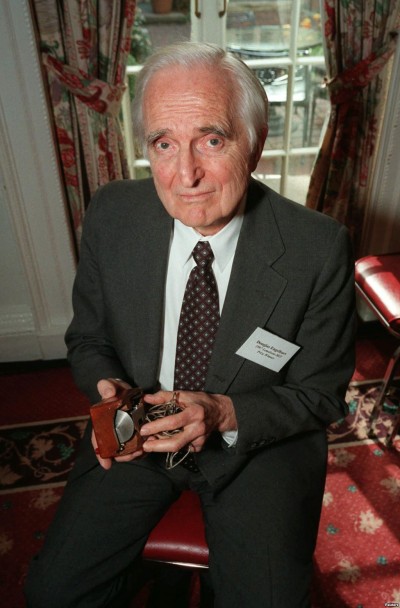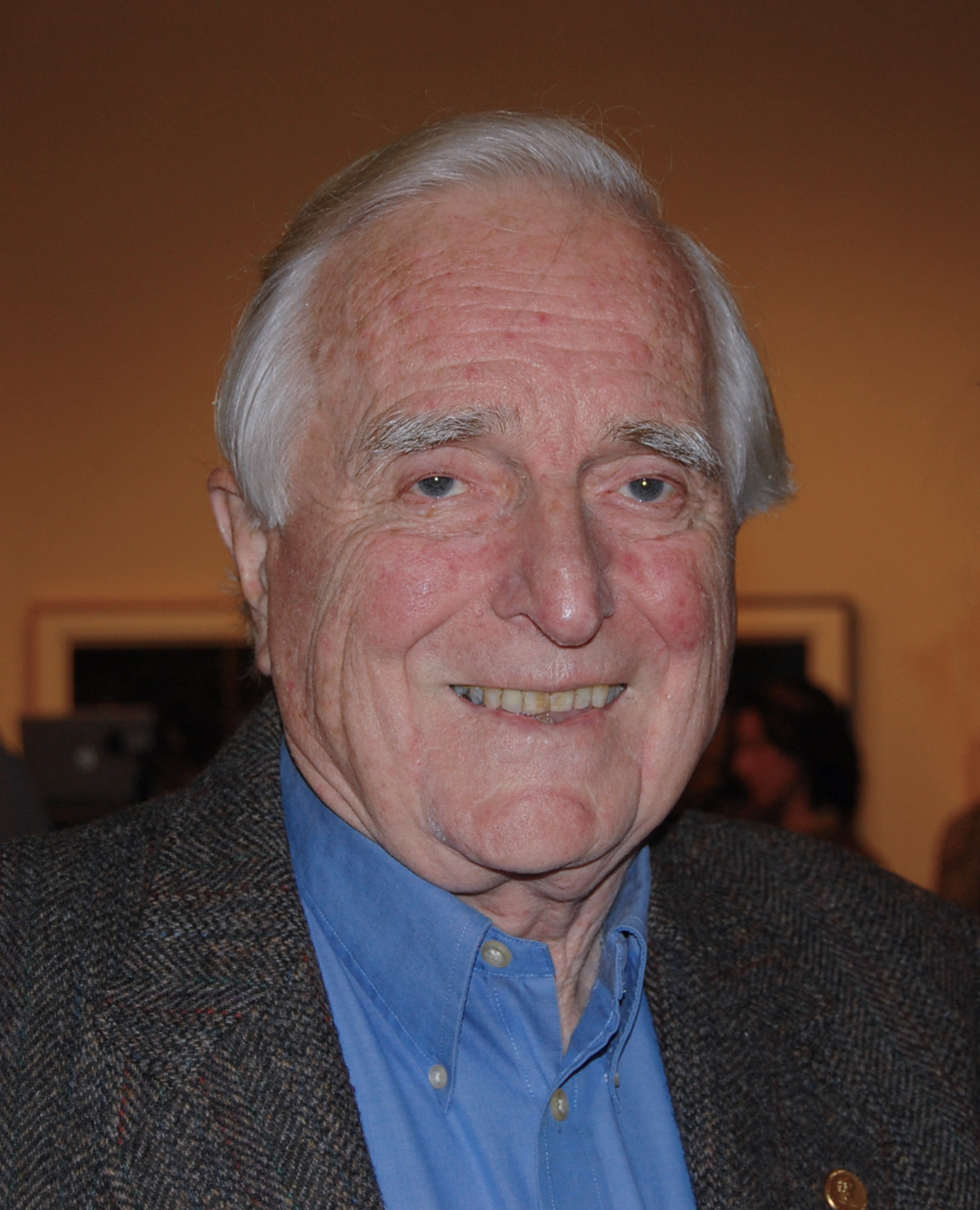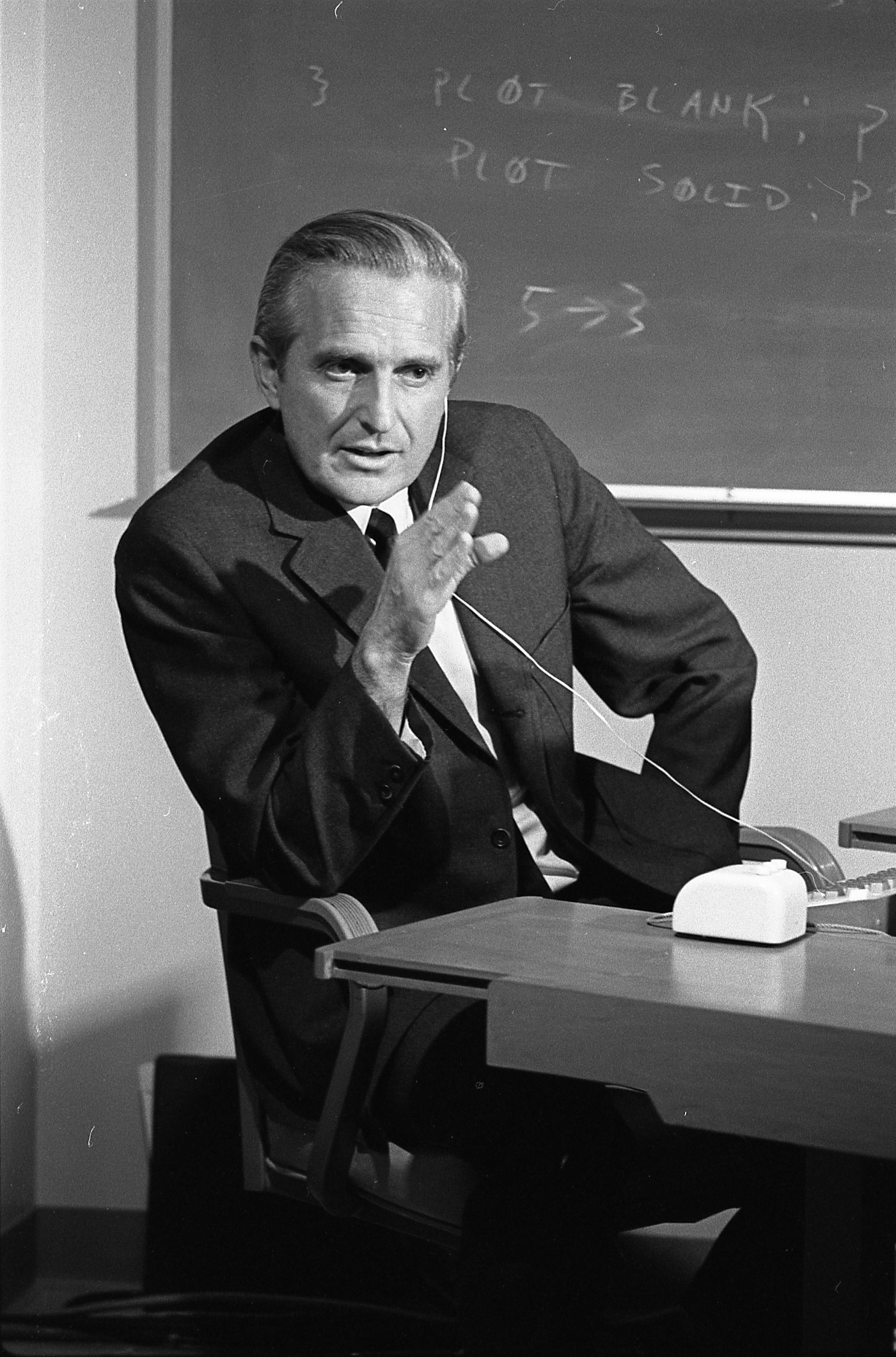Doug Engelbart (Douglas Carl Engelbart)

Engelbart was born in Portland, Oregon on January 30, 1925, to Carl Louis Engelbart and Gladys Charlotte Amelia Munson Engelbart. His ancestors were of German, Swedish and Norwegian descent. He was the middle of three children, with a sister Dorianne (3 years older), and a brother David (14 months younger). The family lived in Portland, Oregon, in his early years, and moved to the surrounding countryside along Johnson Creek when he was 8. His father died one year later. He graduated from Portland’s Franklin High School in 1942. Midway through his college studies at Oregon State College at Corvallis, near the end of World War II, he was drafted into the United States Navy, serving two years as a radar technician in the Philippines. On a small island, in a tiny hut on stilts, he first read Vannevar Bush’s article “As We May Think”, which greatly inspired him. He returned to Oregon State College and completed his Bachelor’s degree in electrical engineering in 1948. While at Oregon State College, he was a member of Sigma Phi Epsilon social fraternity. He was hired by the National Advisory Committee for Aeronautics at the Ames Research Center, where he worked in wind tunnel maintenance. In his off hours he enjoyed hiking, camping, and folk dancing. It was there he met Ballard Fish (August 18, 1928 – June 18, 1997) who was just completing her training as an Occupational Therapist. The two married on May 5, 1951 in Portola State Park. Soon after, Doug left NACA to pursue a PhD at UC Berkeley.
In 1945, Engelbart had read with interest Vannevar Bush’s article “As We May Think”, a call to action for making knowledge widely available as a national peacetime grand challenge. He had also read something about the recent phenomenon of computers, and from his experience as a radar technician, he knew that information could be analyzed and displayed on a screen. He envisioned intellectual workers sitting at display “working stations”, flying through information space, harnessing their collective intellectual capacity to solve important problems together in much more powerful ways. Harnessing collective intellect, facilitated by interactive computers, became his life’s mission at a time when computers were viewed as number crunching tools. He enrolled in graduate school in electrical engineering at University of California, Berkeley, graduating with a Master of Science degree in 1953, and a Ph.D. in 1955. As a graduate student at Berkeley he assisted in the construction of the California Digital Computer project CALDIC. His graduate work led to several patents. After completing his PhD, Engelbart stayed on at Berkeley as an assistant professor to teach for a year, and left when it was clear he could not pursue his vision there. Engelbart then formed a startup company, Digital Techniques, to commercialize some of his doctorate research on storage devices, but after a year decided instead to pursue the research he had been dreaming of since 1951.
Engelbart took a position at SRI International (known then as Stanford Research Institute) in Menlo Park, California in 1957. He initially worked for Hewitt Crane on magnetic devices and miniaturization of electronics; Engelbart and Crane became close friends. At SRI, Engelbart gradually obtained over a dozen patents (some resulting from his graduate work), and by 1962 produced a report about his vision and proposed research agenda titled Augmenting Human Intellect: A Conceptual Framework. This led to funding from ARPA to launch his work. Engelbart recruited a research team in his new Augmentation Research Center (ARC, the lab he founded at SRI). Engelbart embedded a set of organizing principles in his lab, which he termed “bootstrapping strategy”. He designed the strategy to accelerate the rate of innovation of his lab.
The ARC became the driving force behind the design and development of the oN-Line System (NLS). He and his team developed computer interface elements such as bitmapped screens, the mouse, hypertext, collaborative tools, and precursors to the graphical user interface. He conceived and developed many of his user interface ideas in the mid-1960s, long before the personal computer revolution, at a time when most computers were inaccessible to individuals who could only use computers through intermediaries (see batch processing), and when software tended to be written for vertical applications in proprietary systems. Engelbart applied for a patent in 1967 and received it in 1970, for the wooden shell with two metal wheels (computer mouse – U.S. Patent 3,541,541), which he had developed with Bill English, his lead engineer, a few years earlier. In the patent application it is described as an “X-Y position indicator for a display system”. Engelbart later revealed that it was nicknamed the “mouse” because the tail came out the end. His group also called the on-screen cursor a “bug”, but this term was not widely adopted. He never received any royalties for his mouse invention. During an interview, he said “SRI patented the mouse, but they really had no idea of its value. Some years later it was learned that they had licensed it to Apple Computer for something like $40,000.” Engelbart showcased the chorded keyboard and many more of his and ARC’s inventions in 1968 at The Mother of All Demos.
Engelbart slipped into relative obscurity after 1976. Several of his researchers became alienated from him and left his organization for Xerox PARC, in part due to frustration, and in part due to differing views of the future of computing. Engelbart saw the future in collaborative, networked, timeshare (client-server) computers, which younger programmers rejected in favor of the personal computer. The conflict was both technical and social: the younger programmers came from an era where centralized power was highly suspect, and personal computing was just barely on the horizon. Engelbart served on the board of directors of Erhard Seminars Training (EST). Several key ARC personnel were also involved. Although EST had been recommended by other researchers, the controversial nature of EST and other social experiments reduced the morale and social cohesion of the ARC community.
The 1969 Mansfield Amendment, which ended military funding of non-military research, the end of the Vietnam War, and the end of the Apollo program reduced ARC’s funding from ARPA and NASA. SRI’s management, which disapproved of Engelbart’s approach to running the center, placed the remains of ARC under the control of artificial intelligence researcher Bertram Raphael, who negotiated the transfer of the laboratory to a company called Tymshare. Engelbart’s house in Atherton, California burned down during this period, causing him and his family further problems. Tymshare took over NLS and the lab that Engelbart had founded, hired most of the lab’s staff including its creator as a Senior Scientist, renamed the software Augment, and offered it as a commercial service via its new Office Automation Division. Tymshare was already somewhat familiar with NLS; when ARC was still operational, it had experimented with its own local copy of the NLS software on a minicomputer called OFFICE-1, as part of a joint project with ARC. At Tymshare, Engelbart soon found himself marginalized and relegated to obscurity. Operational concerns at Tymshare overrode Engelbart’s desire to do further research. Various executives, first at Tymshare and later at McDonnell Douglas, which acquired Tymshare in 1984, expressed interest in his ideas, but never committed the funds or the people to further develop them. His interest inside of McDonnell Douglas was focused on the enormous knowledge management and IT requirements involved in the life cycle of an aerospace program, which served to strengthen Engelbart’s resolve to motivate the information technology arena toward global interoperability and an open hyperdocument system. Engelbart retired from McDonnell Douglas in 1986, determined to pursue his work free from commercial pressure.
Teaming with his daughter, Christina Engelbart, in 1988 he founded the Bootstrap Institute to coalesce his ideas into a series of three-day and half-day management seminars offered at Stanford University 1989–2000. By the early 1990s there was sufficient interest among his seminar graduates to launch a collaborative implementation of his work, and the Bootstrap Alliance was formed as a non-profit home base for this effort. Although the invasion of Iraq and subsequent recession spawned a rash of belt-tightening reorganizations which drastically redirected the efforts of their alliance partners, they continued with the management seminars, consulting, and small-scale collaborations. In the mid-1990s they were awarded some DARPA funding to develop a modern user interface to Augment, called Visual AugTerm (VAT), while participating in a larger program addressing the IT requirements of the Joint Task Force. Engelbart was Founder Emeritus of the Doug Engelbart Institute, which he founded in 1988 with his daughter Christina Engelbart, who is Executive Director. The Institute promotes Engelbart’s philosophy for boosting Collective IQ—the concept of dramatically improving how we can solve important problems together—using a strategic bootstrapping approach for accelerating our progress toward that goal. In 2005 Engelbart received a National Science Foundation grant to fund the open source HyperScope project. The Hyperscope team built a browser component using Ajax and Dynamic HTML designed to replicate Augment’s multiple viewing and jumping capabilities (linking within and across various documents).
Engelbart attended the Program for the Future 2010 Conference where hundreds of people convened at The Tech Museum in San Jose and online to engage in dialog about how to pursue his vision to augment collective intelligence. The most complete coverage of Engelbart’s bootstrapping ideas can be found in Boosting Our Collective IQ, by Douglas C. Engelbart, 1995. This includes three of Engelbart’s key papers, edited into book form by Yuri Rubinsky and Christina Engelbart to commemorate the presentation of the 1995 SoftQuad Web Award to Doug Engelbart at the World Wide Web conference in Boston in December 1995. Only 2,000 softcover copies were printed, and 100 hardcover, numbered and signed by Engelbart and Tim Berners-Lee. Engelbart’s book is now being republished by the Doug Engelbart Institute.
Two comprehensive histories of Engelbart’s laboratory and work are in What the Dormouse Said: How the Sixties Counterculture Shaped the Personal Computer Industry by John Markoff and A Heritage of Innovation: SRI’s First Half Century by Donald Neilson. Other books on Engelbart and his laboratory include Bootstrapping: Douglas Engelbart, Coevolution, and the Origins of Personal Computing by Thierry Bardini and The Engelbart Hypothesis: Dialogs with Douglas Engelbart, by Valerie Landau and Eileen Clegg in conversation with Douglas Engelbart. All four of these books are based on interviews with Engelbart as well as other contributors in his laboratory. Engelbart served on the Advisory Boards of the University of Santa Clara Center for Science, Technology, and Society, Foresight Institute, Computer Professionals for Social Responsibility, The Technology Center of Silicon Valley, and The Liquid Information Company. Engelbart had four children, Gerda, Diana, Christina and Norman with his first wife Ballard, who died in 1997 after 47 years of marriage. He remarried on January 26, 2008 to writer and producer Karen O’Leary Engelbart. An 85th birthday celebration was held at the Tech Museum of Innovation. Engelbart died at his home in Atherton, California on July 2, 2013, due to kidney failure. According to the Doug Engelbart Institute, his death came after a long battle with Alzheimer’s disease, which he was diagnosed with in 2007. Engelbart was 88 and was survived by his second wife, the four children from his first marriage, and nine grandchildren.
Born
- January, 30, 1925
- USA
- Portland, Oregon
Died
- July, 02, 2013
- USA
- Atherton, California
Cause of Death
- kidney failure



